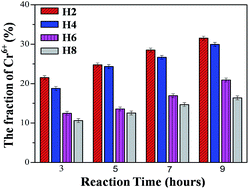The interfacial reaction between sealing glasses and Cr-containing interconnects presents a challenge for the development of Solid Oxide Fuel Cells (SOFCs). In this paper, attention was focused on the relationship between the glass structure of HfO2-containing borosilicate glasses and interfacial reaction between glasses and Crofer 22 APU. The results show that HfO2 dissolves in the glass network with the form of Q2 species and condenses the glass structure of borosilicate glasses. In addition, the fraction of Cr6+ in reaction couples between Cr2O3 and glass powders decreases with increasing HfO2 content from 2 to 8 mol%. Moreover, the thickness of reaction zone is about 1 μm for glass with 2 mol% HfO2/Crofer 22 APU, while no obvious reaction zone can be observed in glass with 8 mol% HfO2/Crofer 22 APU. The reported results support the suitability of the prepared glass-ceramics as sealing materials for SOFCs applications.

